Everyone's right, sorta
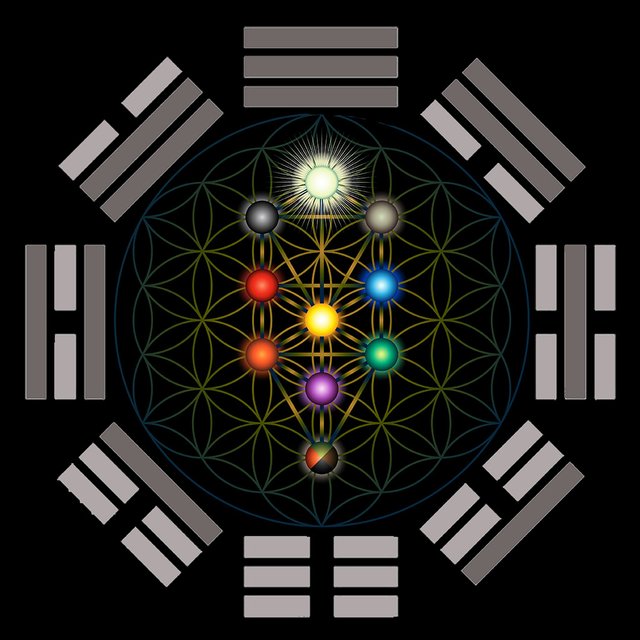
This post is about the rather obscure relationships between some fairly esoteric ideas. If you are not familiar with (or have any interest in) the basics of the I-Ching and the Kabbalah then it is probably not of much interest to you.
If you are still reading then I’ll assume you have at least heard of them, but for the sake of clarity let's do a brief review.
No matter how different various models of creation and reality may be, there seems to be a common core.
The I-Ching
The I-Ching is commonly known as an ancient Chinese form of divination, but this is the mundane understanding of its value. According to history, the legendary emperor Fu Xi observed the patterns of the world and from his understanding of these patterns he created the eight trigrams.
Fu Xi is considered a mythological leader of the 3rd century BC who is said to have invented hunting, fishing, cooking, writing, and humanity itself, much like the legends of Oannes and Osiris and the Fallen Angels. Fu Xi and his sister NuWa were the only survivors of the Great Flood that destroyed all humanity at the time, around 2900 BC (a few hundred years off from the biblical flood story) . He was, in that sense, the Asian Noah, and like Noah, had three sons, and was responsible for rebuilding humanity, but unlike Noah, he had the divine power to breathe life into clay, and it is said that to help rebuild humanity he built many clay figures and brought them to life. As for the I-Ching, it is said that after the flood he was contacted by a great dragon that arose from the Yellow River and imparted this knowledge to him.
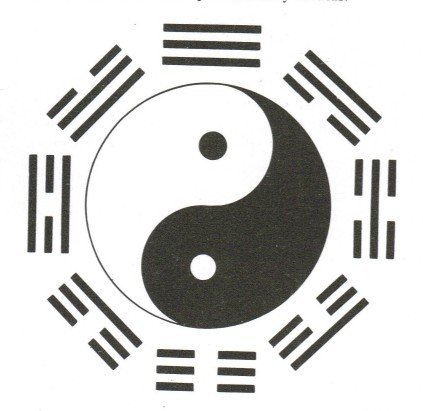
The I-Ching as a whole is made up of hexagrams that are composed of six lines or states. Each state represents a stage of growth and each of those stages can be occupied with either the dark or the light, the yin or the yang. With each of the six states able to occupy one of two conditions, the total number of hexagrams is 26, or 64. These are 64 archetypal states. In addition, each archetypal hexagram has the possibility of changing into another archetype by the dynamic nature of the individual lines, making for a total of 4032 (632)-64 scenarios of change. The name “I Ching” actually translates to "The Book of Changes". If you are a fan of algebra you might find it interesting to note that the 'simplified square root' of 4023 is 24√7… the two numbers we use to represent every moment of every day.
One hexagram is composed of any two set of three lines, called trigrams. There are 23, or 8, unique trigrams, each with it's own meaning. The bottom trigram of a hexagram represents the inner world, and the upper trigram of a hexagram represents the outer world.
The Kabbalah
The Kabbalah is a model of creation and reality that posits 10 static, balanced or archetypal conditions, called “Sefirots”, that are connected to one another via 22 imbalanced, dynamic channels, called the "tzinorot", which represent the energy of creation. These 22 channels are the origins of the Tarot cards used for divination, as well as the Hebrew alphabet itself. The model portrays how all things come into creation via a top-down idea of manifestation, beginning with infinite nothingness. TOut of this 'nothingness' comes teh first movement, which descends through the 'tree' and is permutated through all the various channels and archetypes until it finally reaches the 'bottom' physical reality.
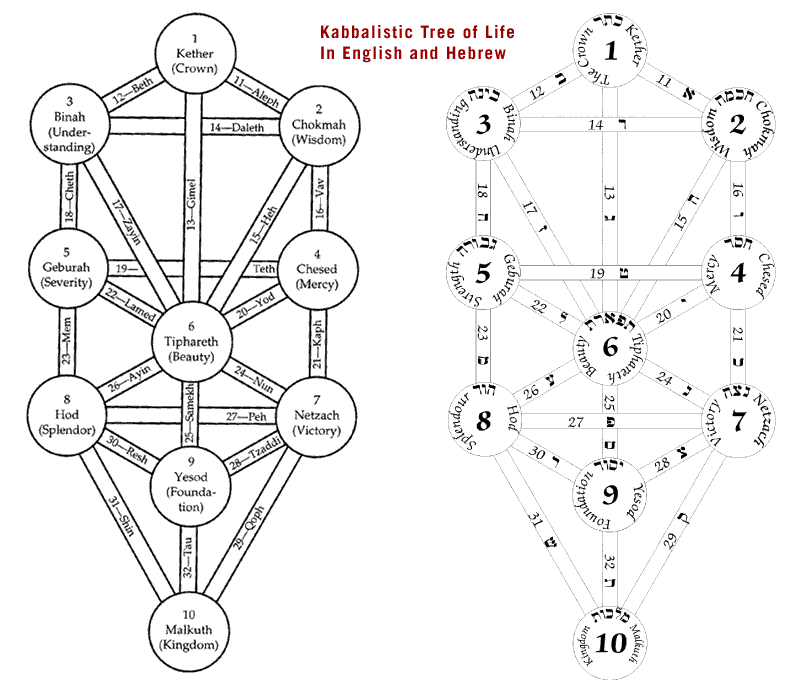
What we know of the Kabbalah today was pretty much reinvented in the 12th and 13th century by the Spanish Jews. It was during this time that it was given the structure, the codification and the analysis that we understand it as today. However, according to legend, the knowledge of the Kabbalah, also known as the 'Tree of Life', or 'Tree of Knowledge', was first given to Adam and Eve by the Archangel Raziel as they were leaving the garden of Eden (which raises a lot of questions). The second man to be given this knowledge was Abraham, around 1700 BC, by the priest-king Melchizedek (Not sure if Melchizedek was a 'man'). Lastly, it was given to Moses the second time he went to the top of Mt. Sinai (the first time was when he received the 10 commandments), and all the angels breathed fire on him to destroy him but he was protected by God.
The first thing that is obvious, besides the fact that angels seem to be a dangerous, trouble-making lot, is that both legends speak of a god/dragon descending/arising from the heavens/river to deliver the same secret knowledge.
A fascinating (soon to be related)) historical side point is that the first recorded schools of mystical thought based on the Kabbalah were those of the 'Merkabah' in the 1st and 2nd centuries. The Merkabah also means “Divine Chariot” and is symbolized, then and now, by the two joined tetrahedrons
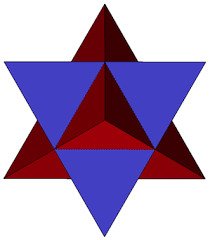
Connections between the Kabbalah and the I-Ching
Here are some more fascinating relationships between this ancient Chinese and ancient Neo-Mesopotamian mysticism: The I-Ching has 64 hexagrams. Each hexagram has its opposite hexagram, so there are 32 pairs of hexagrams. Each pair is made up of an 'ascending' hexagram and a 'descending' hexagram, much like the two tetrahedrons of the Merkabah. Of these 32 pairs of hexagrams, 10 of them are perfectly balanced, having 3 yin and 3 yang lines, and 22 pairs are unbalanced.
When aligning the 10 Sefirot archetypes with the 10 balanced pairs, and the 22 channels with the 22 pairs, it becomes clear to see how both the Kabbalah and the I-Ching are the same 'model', but seen in a circular manner by the Asians, and a top-down, hierarchical manner by the Neo-Mesopotamians. More interesting is that the two ‘poles’ of the Kabbalah, being the ‘first cause’ (god) and the ‘last effect’ (physical reality) are associated with the perfectly balanced hexagrams of Heaven and Earth
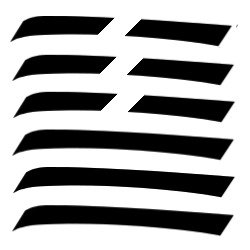 <- 'ascending' hexagram with its 'descending' opposite ->
<- 'ascending' hexagram with its 'descending' opposite -> 
while the two ‘poles’, or extremes of the I-Ching (All yin; 'The Creative', and all Yang; 'The Receptive'),
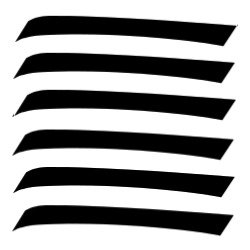 <- 'descending' hexagram and its 'ascending' opposite ->
<- 'descending' hexagram and its 'ascending' opposite -> 
are associated with the Kabbalistic act of manifestation.
This is especially evident when you see that the neo-Mesopotamian idea of God and Creator in the Kabbalah is parallel to the I-Ching concept of heaven on earth, which in the Eastern model is but 1 of 64 possible archetypes, and no more or less important than any other.
No doubt this is why ideologies and beliefs that have come from the Middle East throughout history are predominantly master/minion based (Judaism, Christianity, Islam, etc), while those that came out of the far east are less so (Hindu, Buddhism, Jainism, Taoism, Zen, etc). This is more of a sociological debate which I won’t get into here … I just wanted to raise the point.
(See related post Anamorphose Elephant-Girafes on how the significance of perspective)
I know I may be heading to the "A Beautiful Mind" place here, but as long as I can explain my thinking I assume I am not completely nuts [2]
According to legend, the Torah was written with a white flame on the black void of nothingness[1], as one word. Yes, the entire Torah is one word! The spaces were added by man (again, according to legend). So, let's take the first six letters of the Torah, which also happens to be the first word of the Torah; B-R-A-Sh-Y-Th. This can be either one word, which means "in the beginning" or two words which mean “he created" and "six” [3]. Remember, the spaces as we know them today are arbitrary (according to legend - I will say that a number of times). It is also taught that there are two teachings delivered by God; the Outer Teachings, such as the 10 Commandments and the Torah as is it presented to us today, and the Inner Teaching, such as the secret to the Tree of Knowledge and the secret message of the Torah. So in this tradition, it would not be unusual to find the inner meaning to the Torah by rearranging the spaces that make words, and in fact, this practice has been around for a very long time.
That’s rather interesting, that the first six letters of the word of God happen to mean “he created six”, a message quite similar to that given to Fu Xi by the Dragon in the form of the hexagram. God then went on to create 'everything' in the next six days. Well, what would happen if we converted those six letters into a hexagram, which we can do now because we have a map between the Kabbalah and the I-Ching? It would tell a very interesting story, but I will not get into that here because it is way too long.
There is a story of a rabbi who spent seven years contemplating the first word of the Torah, and after these seven years he was so mystified that he spent the next seven years contemplating the first letter of the first word, which is "Beth", and which also happens to be the hexagram for "Contemplation."

One could go mad spending the rest of their life finding correlations between these two models.
But that is not the point here. The point is that there is a knowledge, a pattern, a 'movement' that is the foundation of all true understanding that the 'gods' have been trying to give us for centuries, and which we only seem to grasp occasional perspectives or glimpses of here and there and then immediately cover it with so much ritual and culture that the true meaning is quickly lost.
With all this in mind, I would like to share a piece of modern history which bring us to today.
Digital Gateway
When the Jesuits, reputed to be the intellectuals among Christian missionaries, invaded China with their religion, they were fascinated by the I-Ching. So much so that they brought it back to Europe in the late 1600s. It was here that Gottfried Wilhelm Leibniz saw the I-Ching and claimed it to be sent by God to him. [4]
Just prior to seeing the I-Ching, Leibniz had developed (discovered?) a number system that he considered sacred. It was the binary system of 0s and 1s, much like the Yin/Yang of the I-Ching. It was of no practical use to anyone, but that was not why he developed it. Leibniz, a very pious man, thought that if all values could be expressed in terms of only something and nothing, on and off, yes and no, positive and negative, etc., then truly, this would be the language of life, for, as he thought, God the Creator was represented as 1, while the void was represented as 0. When he saw the I-Ching, he immediately recognized the solid and broken lines as another representation of his 1 and 0.
At the same time he was inventing this Divine Math meant to explore the hidden secrets of reality, he was inventing the first mechanical calculator suitable not only for addition and subtraction but for multiplication as well. His dream was to make a logical thinking device. [5]
Leibniz was creating tools for the Outer Knowledge and the Inner Knowledge, both based on the same science, but giving two very different answers.
Synchronicity at work.
Some years later, in the middle of the 20th century, a group of modern-day holy men from the western world (called scientists), were building the first modern computer. The problem was how to talk to a computer. To quickly synopsize the whole electronics revolution into one paragraph, imagine someone standing up in this crowd of scientists and calmly saying: "I've got an idea. Let's develop a component that will act as a conductor when a certain amount of voltage is passed through it but will act as an insulator when less than that amount of voltage is attempted to be passed through it. We will call this component a gate. Because this gate can only respond to one of two states, high or low voltage, yes or no, so to speak, which represents the most basic principles of reasoning, we will call it a logic gate. Any problem that can be dissolved or broken down into so many yes-or-no conditions can be calculated by these logic gates. We can use the numbers 1 and 0 to represent these states. Because the heart of these electronic machines will be made up of these yes-or-no circuits, we will call them Digital Circuits". And the digital computer as we know it today was invented.
If Leibniz was alive today to see this invention he would recognize it as both a tool of practical use as well as a tool of great esoteric potential, a key to the secret knowledge he was looking for. He would recognize the computer as the fruition of both of his dreams.
The ancients had gods popping out of rivers and dropping from heaven to impart this wisdom to a select few. Today we have the computer, created by man, who himself was (according to legend) not only created in the image of his creator but given (stole, really) the secret to the mysteries of life… a fact that seems to still piss off God, as we are still paying for that alleged sin. Just like the I-Ching, the Kabbalah, and every other tool of sacred knowledge, the computer is primarily used for the mundane, for 'divination', for 'practical' purposes, and it is quickly being buried with the new digital culture and tradition that almost guarantees it will never be used for discovering the secrets of reality except by a very select few. Technology has replaced religion, but like religion, its original message is getting corrupted and lost.
Addendum
Minutes after publishing this post I received a totally unrelated link from a friend of a short talk that explains the illusion of space-time [6]. It is very good, but I was not totally satisfied with his presentation. I began looking for another talk that better answered the questions raised in the first video, and I ran across this video "The end of Space And Time?" It is a very good lecture on physics presented to a group of economists, so it is explained in an understandable way.
I was amazed when Prof. Dijkgraaf began explaining the "Holographic Principle"[10] that theorizes that the "Horizon" of a black hole (in effect, the surface of a black hole) can not only be represented as a series of 1's and 0's, each 'bit' representing one area of this surface (a very small area known as the Planck Length [7]), but that these 1's and 0's are actually a 2 dimension digital representation of everything that has, is or ever will exist in three dimensional reality, much like a 2-dimensional hologram can reproduce a 3-dimensional object, hence the name "Holographic Principle".
What really jumped out at me was this image in the video.
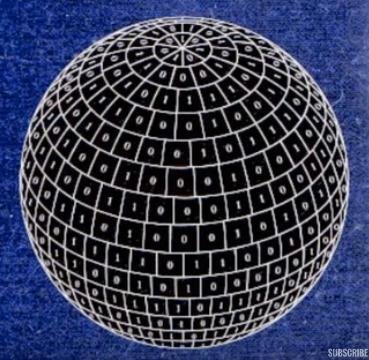
This is a representation of what the surface of a black hole would 'look' like, and this collection of 'bits' represent all reality across all time. Two things struck out at me when I saw this, 1) This model can explain all reality in 1's and 0's, not unlike the I-Ching and its Kabbalah cousin, and 2) This looks incredibly similar to the description of how the original Torah was presented, as a very long string of characters, represented as flames against the background of a black void. (and you don't get much closer to a black void than a black hole). Instead of flames that formed the Hebrew alphabet, it is now 1's and 0's, the new language of communication and understanding. It also raises the ideas that, were this reality a simulation, perhaps the 'coding' behind it is a base 22 (as opposed to a base-2/binary) form of math. In other words, rather than just having 2 states per bit, there were 22 states per bit. Interestingly, something approaching this is being realized in the area of Quantum Computing. [8][9]
The most pleasantly surprising detail of this video was how it (it's predecessor, actually) arrived not more than 20 minutes after I published this post.
Footnotes:
- [1] http://jbq.jewishbible.org/assets/Uploads/352/352_fire.pdf
- [2] http://xwalk.ca/torah.html
- [3] This is a common practice and is accepted by even traditionalists: for example http://www.torah.org/learning/perceptions/5764/yis...
- [4] http://www.wikiwand.com/en/Gottfried_Wilhelm_Leibniz, http://www.wikiwand.com/en/Binary_number#/Leibniz_and_the_I_Ching
- [5] http://history-computer.com/Dreamers/Leibniz.html
- [6]
- [7] http://www.wikiwand.com/en/Planck_length. To put things in perspective, the number of bits that would be needed to populate just one square meter of the surface of a black hole 'horizon' is 10^1225, that 1 followed by 1,225 0's. If a black hole was as small as Jupiter, which has 6.2x10^10 km2 of surface area, the number of bits on the surface would be 1 followed by 12,250 0's (if my math is correct, which it may well not be, but it's kind of a moot point as in any case, with any math, the number is going to be astronomical).
- [8] Referring to footnote [7], if this was the case, then the possible number of states for one square meter on a black hole horizon would jump from 2^(10^1225) to 22^(10^1225). I do not know how big that number is, but considering that 22^8=54,875,873,536 we can say with confidence it is a very big number. To put in another way, the number of plank-lengths bits in a micrometer (about 1/100 the width of a human hair) will hold 2^57 states, which is 1.4411519e+17, so 22^57 would hold 3.2968016e+76. Therefore in the area of the width of one human hair, there could be 3.2968016e+80 states represented. What's that look like?
32,968,000,000,000,000,000,000,000,000,000,000,000,000,000,000,000,000,000,000,000,000,000,000,000,000,000
[9] Computational capacity of the universe, Seth Lloyd (MIT), 24 Oct 2001) https://arxiv.org/abs/quant-ph/0110141. "This paper quantifies the amount of information that the universe can register and the number of elementary operations that it can have performed over its history. The universe can have performed no more than 10^120 ops on 10^90 bits."
- [10] This is one of the best videos out there on the subject of spacetime, and so much more. It's linked to above, but I am embedding it here as well from the beginning.